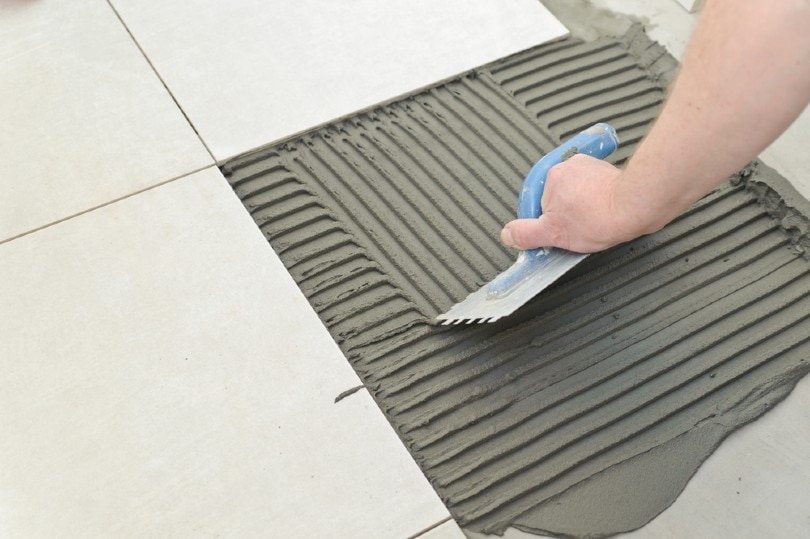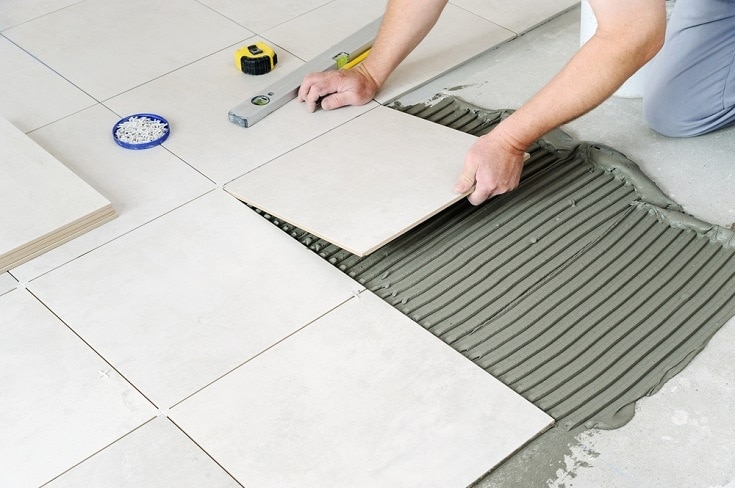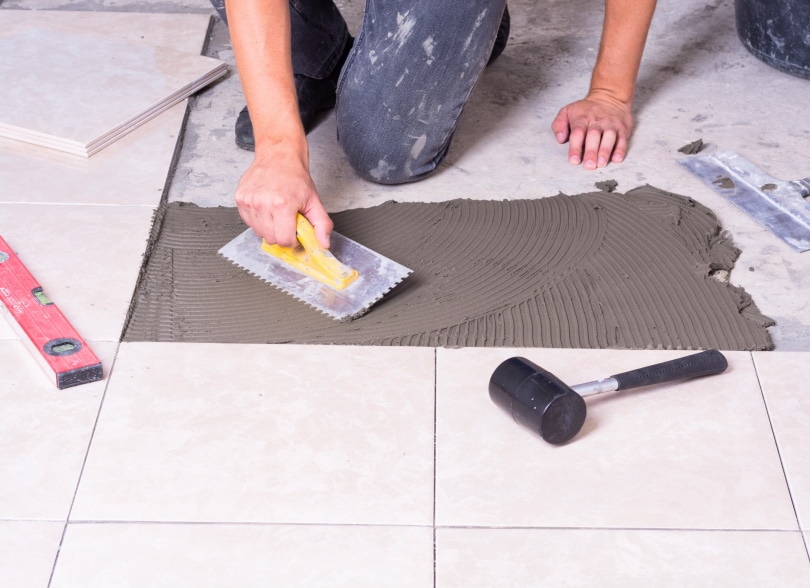How Long Does Tile Mortar Take to Dry? Timeline, Factors, & FAQ
-
Greg Iacono
- Last updated:

Finishing a home improvement or renovation project is an exciting time, as everything comes together and the end is finally in sight. One small problem, though, is many homeowners tend to rush the last few steps in anticipation, one of which is the laying of tiles on floors and walls. That can be a problem since tile mortar, the binding material used to keep tiles in place, needs to dry before being used for the first time.
If you’re asking yourself, “How long does tile mortar take to dry?” the answer is that thinset mortar, the type typically used for tiles, dries in 24 to 48 hours. Also, several thinset mortar brands recommend waiting up to 72 hours before using your new tiles for the first time. When you consider the average construction or renovation project takes 3 to 8 months to complete, we think you’ll agree an extra 2 to 3 days of patience isn’t too much to ask. If you have more questions about tile mortar, laying tile, drying times, curing times, and so forth, please continue reading. We have information below to answer all your questions and some expert advice, too!
Are There Tile Mortars That Take Less Time to Dry?
If time is a factor and you need to use your newly tiled floor or wall faster, you can purchase several quick-setting tile mortar brands. These tile mortars usually need 2 to 3 hours to dry before you can start grouting and an additional 6 hours before walking on them. It’s highly recommended that you read and follow the instructions and use the correct amount of water to get optimal results.

Can You Mortar Tile and Grout the Same Day?
The answer to this question depends on the tile mortar you use to lay your tiles. If you use traditional, thinset mortar, experts recommend waiting at least 24 hours before grouting so that the mortar can “set” and the tile and surface (wall or floor) can fuse correctly. Additionally, if you live in a humid area or the weather is cool, you should wait for an additional 12 to 24 hours before grouting.
As we mentioned earlier, if you use a quick-setting tile mortar, you can tile and grout on the same day. That’s because the quick-setting mortar will be ready in about 2 to 3 hours, after which grouting can be performed without any risk of a problem developing later.
How Long Does Tile Mortar Take To Dry Completely?
Even though 24 to 48 hours are recommended to let the tile mortar dry, it doesn’t dry completely for about 1 month.
- Within the first 24 hours, the mortar dries about 60%.
- Within 24 to 48 hours, the mortar “sets,” and you can apply grout.
- In 28 days, the mortar is cured and dried completely.
Does a Fan Help Tile Mortar Dry Faster?
If drying your tile mortar faster is necessary, and you aren’t using quick-setting mortar, a fan can be helpful. A fan circulates the air in the room being tiled, maximizing airflow. This maximized airflow, in turn, increases the rate of evaporation, which helps the mortar dry more quickly. You can also use a space heater or a dehumidifier to attain the same, faster-drying results.
What Is the Difference Between Drying and Curing Tile Mortar?
Tile mortar is a cement-based product that needs to dry for a specific time before it’s stable enough for grouting and everyday use. As a cement-based product, time mortar also needs time to cure, which is quite different from drying. That’s because tile mortar has certain adhesives and chemicals that, when mixed with water, cause a chemical reaction that bonds the mortar to the surface being tiled and to the tile surface.
This chemical reaction is a process called “curing” and has nothing to do with the evaporation of water from tile grout, known as drying. Although the two processes are quite different, be aware that some companies and publications use the terms interchangeably. The technical term for curing is polymerization. Like drying, curing tile mortar is a critical part of laying tile and should be done following recommended manufacturer’s instructions.
What is the Difference Between Mortar, Cement, and Concrete?
Many DIYers are unsure of the difference between concrete, mortar, and cement and, in many cases, believe the three substances are similar. However, this couldn’t be further from the truth, as all three are different and used for other purposes. Let’s take a look at those differences.

Cement
Cement is a very fine powder used to make mortar and concrete and acts as a glue. Technically, concrete is known as a “binding agent.” Cement will first set and harden when mixed with water and other materials. Ultimately, it will bind together whatever materials it touches.
Mortar
Mortar, including tile mortar, is made of cement, fine sand, and lime. Once mixed with water, mortar is used as a binding material, similar to glue. You can then use it to bind bricks, blocks, stone, and other building materials. Mortar is also used to bind tile to walls and floors.
Concrete
Concrete is similar to mortar in that it also contains cement and sand. However, the sand isn’t nearly as fine, and concrete also has an extra “aggregate,” or geological material. Typical aggregates include crushed rock and gravel. Sand is also an aggregate, which is why we mentioned that concrete has an “extra” one. Also, while the mortar is a strong substance, concrete is incredibly strong once cured.
Can You Walk On Tile While Laying It?
You shouldn’t walk on the tile while you’re laying it. Doing so can cause several problems, including cracking the mortar and shifting the tiles. Even worse is that if you don’t notice the issues before the mortar cures, correcting the mistake could be costly and time-consuming.
If you must walk over a freshly tiled floor before it’s had time to dry, flooring experts recommend laying a sheet of thick plywood on the floor. Walking on the plywood rather than on the tiles will distribute your weight more evenly over the entire surface than on an individual tile. This trick will substantially lower the risk of a tile or tiles getting shifted or cracked by your weight or damaging the underlying mortar.

What Can Cause Tile Mortar to Take Longer to Dry?
When mixed with the correct amount of water, tile mortar will usually dry in 24 to 48 hours. Several conditions can increase the drying time, however. They include:
Very High Humidity
If you live in a tropical or sub-tropical area of the world with a high humidity level, your mortar will need extra time to dry. The opposite is true if you live in an arid region.
A Small Grout Joint
To dry and cure, the mortar you use must be exposed to air. If you use a small (technically, thin) grout joint between tiles, the amount of air that gets through will be decreased, increasing the mortar’s drying time.
Ceramic and Porcelain Tiles
Unlike natural stone tiles, ceramic and porcelain tiles are not porous, which means they don’t absorb moisture. That’s why your mortar will take longer to dry if you use either of these manufactured tiles.
Using Pre-Mixed Mortar
Pre-mixed mortar is ready to use without the need to mix it with water. However, because of this fact, premixed mortar takes over 6 days to dry and in humid or cold conditions, it takes 2 weeks.
Final Thoughts
It takes about 24 to 48 hours under normal conditions for tile mortar to dry. If you’re laying or installing tile in an overly humid or cold area, the drying time can be increased by up to 2 weeks. We’ve also seen that even though manufacturers suggest 24 to 48 hours, the actual time to completely dry and cure tile mortar can be as much as 30 days. However, you can still walk on it after 24 to 48 hours. Our article answered all your questions about tile mortar drying time and provided real-world answers that will help your latest home project be a smashing success!
See also:
Featured Image Credit: DUO Studio, Shutterstock
Contents
